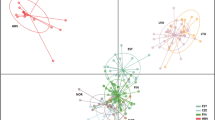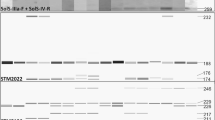Abstract
Certain Native Americans from the Pacific Northwest and Alaska of the USA have grown potatoes in their gardens for many generations. In this study, the origin of several potatoes collected from Native gardens was investigated. Fourteen SSR markers covering the 12 potato homologs yielding a total of 199 alleles were amplified and scored in Solanum tuberosum Group Andigena (52 accessions), S. tuberosum Group. Tuberosum (39 accessions) and wild species (6 accessions). “Ozette” from the Makah Nation on the Olympic Peninsula in Washington State was closely related to “Maria’s” and “Kasaan” potatoes collected from Native Alaskan gardens in Southeast Alaska. These three potatoes were more closely related to either two Mexican and one Peruvian andigena accessions or three Chilean Group Tuberosum accessions, while being relatively less related to the old European or modern varieties and most distantly related to Group Andigenum. “To-Le-Ak” was closely related to two Chilean tuberosum accessions and one old European variety. All Native potatoes harbored T-type chloroplast genome indicating that their maternal lineage is shared with Chilean Group Tuberosum. Using genetic relationship as a guide to origin it appears plausible that the Native American/Alaskan cultivars are either directly or indirectly from Mexico and Chile. These Native potato cultivars present a possible second route of diffusion distinct from the South America to Europe transfer which has been assumed to the sole means by which potato was spread out of South America.




Similar content being viewed by others
References
Bonierbale MW, Plaisted RL, Tanksley SD (1988) RFLP maps based on a common set of clones reveal modes of chromosomal evolution in potato and tomato. Genetics 120:1095–1103
Bryan GJ, McNicoll J, Ramsay G, Meyer RC, De Jong WS (1999) Polymorphic simple sequence repeat markers in chloroplast genomes of Solanaceous plants. Theor Appl Genet 99:859–867
Chakraborty R, Jin L (1993) Determination of relatedness between individuals by DNA fingerprinting. Hum Biol 65:875–895
Cutter DC (1991) Malaspina and Galiano: Spanish voyages to the northwest coast, 1791 and 1792. University of Washington Press, Seattle, p 160
Dice LR (1945) Measurement of the amount of ecological association between species. Ecology 26:295–302
Doyle JJ, Doyle JL (1987) A rapid DNA isolation procedure from small quantities of fresh leaf tissues. Phytochem Bull 19:11–15
Feldman MW, Kumm J, Pritchard JK (1999) Mutation and migration in models of microsatellite evolution. In: Goldstein DB, Schlotterer C (eds) Microsatellites: evolution and applications. Oxford University Press, Oxford, pp 98–115
Felsenstein J (1993) PHYLIP, Phylogeny inference package, Version 3.5c. University of Washington, Seattle
Gebhardt C, Ritter E, Debener T, Schachtschabel U, Walkemeier B, Uhrig H, Salamini F (1989) RFLP-analysis and linkage mapping in Solanum tuberosum. Theor Appl Genet 78:65–75
Ghislain M, Spooner DM, Rodríguez F, Villamon F, Nuñez J, Vásquez C, Waugh R, Bonierbale M (2004) Selection of highly informative and user-friendly microsatellites (SSRs) for genotyping of cultivated potato. Theor Appl Genet 108:881–890
Gibson JR (1999) Otter skins, Boston ships, and China trade: the maritime fur trade of the Northwest coast, 1785–1841. University of Washington Press, Seattle, p 448
Gill SJ (1983) Ethnobotany of the Makah and Ozette people, Olympic Peninsula, Washington (USA), Doctoral Dissertation. Department of Botany, Washington State University, Pullman WA, pp 441
Goldstein DB, Pollock DD (1997) Launching microsatellites: a review of mutation processes and methods of phylogenetic inference. J Hered 88:335–342
Goldstein DB, Ruiz Linares A, Cavalli-Sforza LL, Feldman MW (1995a) Genetic absolute dating based on microsatellites and the origin of modern humans. Proc Natl Acad Sci 92:6723–6727
Goldstein DB, Ruiz Linares A, Cavalli-Sforza LL, Feldman MW (1995b) An evaluation of genetic distances for use with microsatellite loci. Genetics 139:463–471
Grun P (1990) The evolution of cultivated potatoes. Econ Bot 44(3 Suppl.):39–55
Grun P, Staub J (1979) Evolution of tetraploid cultigens from the view of cytoplasmic inheritance. In: Report of the planning conference on the exploration, taxonomy and maintenance of potato germ plasm III. International Potato Center, Lima, Peru pp 141–152
Hawkes JG (1990) The potato: evolution, biodiversity and genetic resources. Belhaven Press, London, UK, p 259
Hosaka K (1995) Successive domestication and evolution of the Andean potatoes as revealed by chloroplast DNA restriction endonuclease analysis. Theor Appl Genet 90:356–363
Hosaka K (2002) Distribution of the 241 bp deletion of chloroplast DNA in wild potato species. Am J Bot 79:119–123
Hosaka K, Hanneman RE Jr (1998) Genetics of self-compatibility in a self-incompatible wild diploid potato species Solanum chacoense. 1. Detection of an S locus inhibitor (Sli) gene. Euphytica 99:191–197
Hosaka K, de Zoeten GA, Hanneman RE Jr (1988) Cultivated potato chloroplast DNA differs from the wild type by one deletion––evidence and implications. Theor Appl Genet 75:741–745
Huamán Z, Spooner DM (2002) Reclassification of landrace populations of cultivated potatoes (Solanum sect. Petota). Am J Bot 89:947–965
Kawagoe Y, Kikuta Y (1991) Chloroplast DNA evolution in potato (Solanum tuberosum L.). Theor Appl Genet 81:13–20
Kawchuk LM, Lynch DR, Thomas J, Penner B, Sillito D, Kulcsar F (1996) Characterization of Solanum tuberosum simple sequence repeats and application to potato cultivar identification. Am Potato J 73:325–335
Kirk R, Alexander C (1990) Exploring Washington’s past: a road guide to history. University of Washington Press, Seattle, p 542
Lara-Cabrera S, Spooner DM (2005) Taxonomy of Mexican diploid wild potato (Solanum sect. Petota) species: morphological and microsatellite data. Monogr Syst Bot Mo Bot Gard 104:199–205
Matsuoka Y, Vigouroux Y, Goodman MM, Sanchez GJ, Buckler E, Doebley J (2002) A single domestication for maize shown by multilocus microsatellite genotyping. Proc Natl Acad Sci USA 99:6080–6084
McDonald L (1972) Swan among the Indians. Binford and Mort, Publishers, Portland, OR 233pp
Milbourne D, Meyer RC, Collins AJ, Ramsay LD, Gebhardt C, Waugh R (1998) Isolation, characterization and mapping of simple sequence repeat loci in potato. Mol Gen Genet 259:233–245
Miller JT, Spooner DM (1999) Collapse of species boundaries in the wild potato Solanum brevicaule complex (Solanaceae, S. sect. Petota): molecular data. Plant Syst Evol 214:103–130
Mitchell SE, Kresovich S, Jester CA, Hernandez CJ, Szewc-McFadden AK (1997) Application of multiplex PCR and fluorescence-based, semi-automated allele sizing technology for genotyping plant genetic resources. Crop Sci 37:617–624
Moziño JM (1991) Noticias de Nutka: an account of Nootka Sound in 1792. University of Washington Press, Seattle, WA, p 142
Nei M (1972) Genetic distance between populations. Am Nat 106:283–292
Nei M, Li WH (1979) Mathematical model for studying genetic variation in terms of restriction endonucleases. Proc Natl Acad Sci 76:5269–5273
Peakall R, Gilmore S, Keys W, Morgante M, Rafalski A (1998) Cross-species amplification of soybean (Glycine max) simple sequence repeats (SSRs) within the genus and other legume genera: implications for the transferability of SSRs in plants. Mol Biol Evol 15:1275–1287
Provan J, Powell W, Waugh R (1996) Microsatellite analysis of relationships within cultivated potato (Solanum tuberosum). Theor Appl Genet 92:1078–1084
Raker C, Spooner DM (2002) The Chilean tetraploid cultivated potato, Solanum tuberosum, is distinct from the Andean populations; microsatellite data. Crop Sci 42:1451–1458
Rohlf JF (2007) NTSYSpc: numerical taxonomy system, Ver. 2.20. Exeter Publishing, Ltd, Setauket, NY
Schneider K, Douches DS (1997) Assessment of PCR-based simple sequence repeats to fingerprint North American potato cultivars. Am Potato J 74:149–160
Sosinski B, Douches DS (1996) Use of PCR-based DNA amplification to fingerprint North American potato cultivars. HortScience 31(1):130–133
Spooner DM, Hetterscheid WLA (2005) Origins, evolution, and group classification of cultivated potatoes. In: Motley TJ et al (eds) Darwin’s harvest: new approaches to the origins, evolution and conservation of crops. Columbia Univ. Press, New York, pp 285–307
Spooner DM, Mclean K, Ramsay G, Waugh R, Bryan GJ (2005a) A single domestication for potato based on multilocus amplified fragment length polymorphism genotyping. Proc Natl Acad Sci 102(41):14694–14699
Spooner DM, Nuñez J, Rodriguez F, Naik PS, Ghislain M (2005b) Nuclear and chloroplast DNA reassessment of the origin of Indian potato varieties and its implications for the origin of the early European potato. Theor Appl Genet 110:1020–1026
Suttles W (1951) The early diffusion of the potato among the Coast Salish. Southwest J Anthropol 7:272–288
Swan JG (1868) The Indians of Cape Flattery at the entrance to the Strait of Juan de Fuca, Washington Territory. Smithsonian Institution “Contributions to Knowledge,” Facsimile Reproduction, 1964, 108 pp
Turner NJ (1975) Food plants of British Columbia Indians, Part 1, coastal peoples. British Columbia Provincial Museum Handbook, No. 34. British Columbia Provincial Museum, Victoria
Turner NJ (1995) Food plants of coastal first peoples. Royal British Columbia Museum Handbook series. UBC Press
Veilleux RE, Shen LY, Paz MM (1995) Analysis of the genetic composition of anther-derived potato by randomly amplified polymorphic DNA and simple sequence repeats. Genome 38:1153–1162
Wagner HR (1933) Spanish explorations in the Strait of Juan de Fuca. Fine Arts Press, Santa Ana, CA
Westman AL, Kresovich S (1998) The potential of cross-taxa simple-sequence repeat (SSR) amplification between Arabidopsis thaliana L. and crop brassicas. Theor Appl Genet 96:272–281
Zane L, Bargelloni L, Patarnello T (2002) Strategies for microsatellite isolation: a review. Mol Ecol 11(1):1–16
Acknowledgements
This research is a part of the Potato Genome Project funded by National Science Foundation. We thank the Makah (Neah Bay, Washington), Tlingit, Quillayute and Haida Nations for their help and support.
Author information
Authors and Affiliations
Corresponding author
Rights and permissions
About this article
Cite this article
Zhang, L., Brown, C.R., Culley, D. et al. Inferred origin of several Native American potatoes from the Pacific Northwest and Southeast Alaska using SSR markers. Euphytica 174, 15–29 (2010). https://doi.org/10.1007/s10681-009-0092-4
Received:
Accepted:
Published:
Issue Date:
DOI: https://doi.org/10.1007/s10681-009-0092-4




